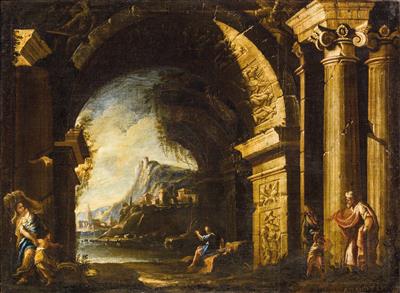Ascanio Luciani – a pair (2)

(Napels 1621–1706)
A pair of architectural capricci with scenes from the Old Testament, Abraham with the three angels and the expulsion of Hagar and Ismael,
one signed lower right: Ascianus Lucia...,
oil on canvas, each 75 x 102 cm, framed, a pair (2)
Born in Naples, Ascanio Luciani was thirteen when the architectural painter Viviano Codazzi arrived in 1634. When Codazzi left for Rome, Luciani was only twenty-six. Whilst clearly heavily influenced by Codazzi, Luciani was still a young man when he established his own studio and later developed an unmistakably individual style. However, as David Marshall observes, Luciani had clearly been working in Codazzi’s studio during these early years (see: D. R. Marshall, ‘Ascanio Luciani a Neapolitan follower of Viviano Codazzi’, in: Paragone 39, Florence 1988). By 1647 he had become a prolific artist in his own right. In the past, many of his works were wrongly attributed to Codazzi, to such a degree that he earned the name “Pseudo-Codazzi”. Recent research and analysis has helped to establish Luciani as an independent and very talented personality and recent market results show a stronger appreciation of his works. After Codazzi’s departure, Luciani’s style developed more individual qualities; he became less focused on precise architectural rendering, and more interested in colourful effect and, occasionally, in portraying various sacred and Biblical scenes. Among these are The Massacre of the Innocents (Lyon, Musée des Beaux-Arts, Inv. A2741) and Christ Expelling the Money-changers from the Temple (Naples, Pinacoteca dell’Accademia di Belle arti). In 1665, Luciani is documented as a member of the Corporazione dei Pittori Napoletani.
Only some of Luciani’s late works are signed. The present painting, which shows the expulsion of Hagar and Ismael, signed Ascianus Lucia…, is very similar to a version, which Marshall dates to circa 1691 (see: D. R. Marshall, Viviano and Niccolò Codazzi and the Baroque Architectural Fantasy, Rome 1993, Cat. AL 53).
Esperto: Dr. Alexander Strasoldo
 Dr. Alexander Strasoldo
Dr. Alexander Strasoldo
+43 1 515 60 403
old.masters@dorotheum.com
18.10.2016 - 18:00
- Prezzo realizzato: **
-
EUR 54.620,-
- Stima:
-
EUR 40.000,- a EUR 60.000,-
Ascanio Luciani – a pair (2)
(Napels 1621–1706)
A pair of architectural capricci with scenes from the Old Testament, Abraham with the three angels and the expulsion of Hagar and Ismael,
one signed lower right: Ascianus Lucia...,
oil on canvas, each 75 x 102 cm, framed, a pair (2)
Born in Naples, Ascanio Luciani was thirteen when the architectural painter Viviano Codazzi arrived in 1634. When Codazzi left for Rome, Luciani was only twenty-six. Whilst clearly heavily influenced by Codazzi, Luciani was still a young man when he established his own studio and later developed an unmistakably individual style. However, as David Marshall observes, Luciani had clearly been working in Codazzi’s studio during these early years (see: D. R. Marshall, ‘Ascanio Luciani a Neapolitan follower of Viviano Codazzi’, in: Paragone 39, Florence 1988). By 1647 he had become a prolific artist in his own right. In the past, many of his works were wrongly attributed to Codazzi, to such a degree that he earned the name “Pseudo-Codazzi”. Recent research and analysis has helped to establish Luciani as an independent and very talented personality and recent market results show a stronger appreciation of his works. After Codazzi’s departure, Luciani’s style developed more individual qualities; he became less focused on precise architectural rendering, and more interested in colourful effect and, occasionally, in portraying various sacred and Biblical scenes. Among these are The Massacre of the Innocents (Lyon, Musée des Beaux-Arts, Inv. A2741) and Christ Expelling the Money-changers from the Temple (Naples, Pinacoteca dell’Accademia di Belle arti). In 1665, Luciani is documented as a member of the Corporazione dei Pittori Napoletani.
Only some of Luciani’s late works are signed. The present painting, which shows the expulsion of Hagar and Ismael, signed Ascianus Lucia…, is very similar to a version, which Marshall dates to circa 1691 (see: D. R. Marshall, Viviano and Niccolò Codazzi and the Baroque Architectural Fantasy, Rome 1993, Cat. AL 53).
Esperto: Dr. Alexander Strasoldo
 Dr. Alexander Strasoldo
Dr. Alexander Strasoldo
+43 1 515 60 403
old.masters@dorotheum.com
|
Hotline dell'acquirente
lun-ven: 10.00 - 17.00
old.masters@dorotheum.at +43 1 515 60 403 |
| Asta: | Dipinti antichi |
| Tipo d'asta: | Asta in sala |
| Data: | 18.10.2016 - 18:00 |
| Luogo dell'asta: | Wien | Palais Dorotheum |
| Esposizione: | 08.10. - 18.10.2016 |
** Prezzo d’acquisto comprensivo dei diritti d’asta acquirente e IVA(Paese di consegna Austria)
Non è più possibile effettuare un ordine di acquisto su Internet. L'asta è in preparazione o è già stata eseguita.
